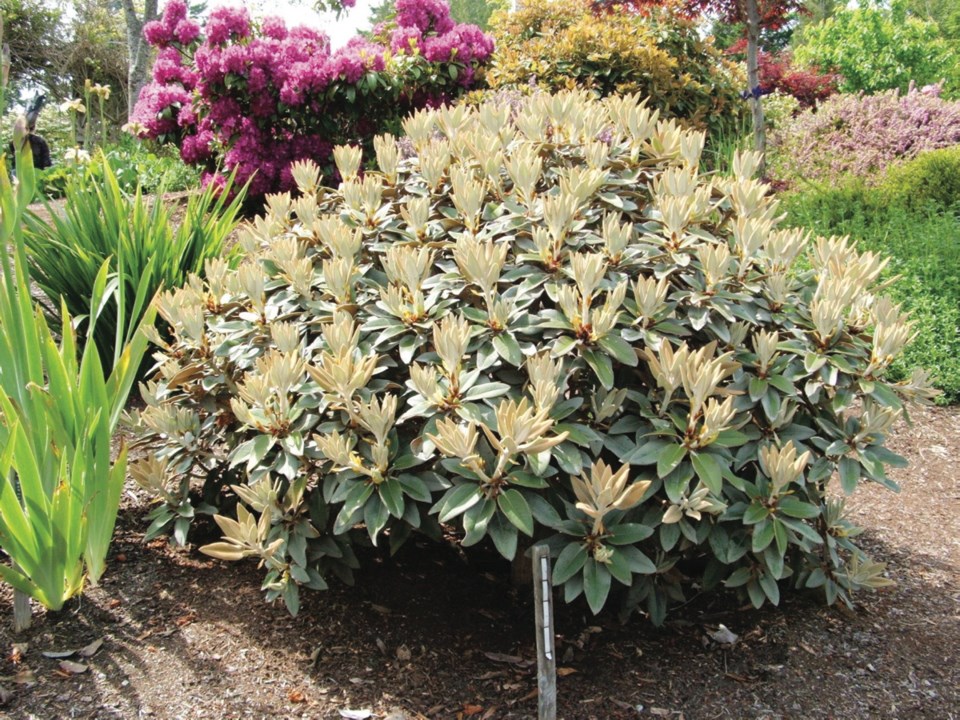Dear Helen: Will the forget-me-not plants that have appeared in my garden produce flowers in the spring, or will they die off in winter? Should I preserve the plants, dig them under, or put them on the compost?
Z.D.
Common garden forget-me-not (Myosotis sylvatica) is a biennial plant. It is seeded in summer and transplanted in early autumn. Once in a garden, the plants seed themselves to form little rosettes of bright green, hairy leaves. The young plants overwinter well and flower throughout the spring.
Unwanted plants are easily pulled up and composted, or dug under to compost “on-site.”
Dear Helen: Last year my late-blooming rhododendrons were hit with high temperatures immediately after they finished flowering. Hot sun burned the new foliage. Should I replace the shrubs in the spring or will they come back and flower again?
T.M.
Unless the damage was enough to cause most of the foliage to burn and dry off, the plants may well grow fresh foliage in the spring. To tell whether there will be flowers, look for fat buds already formed on the plants.
If the shrubs are fairly well established, and a similar foliage burning has not occurred before, chances are they will re-grow in the spring. Leave them until then, and with re-growth mulch with compost, or compost and fine fir bark, and keep the soil consistently and adequately moist through the summer as the shrubs set flower buds.
Dear Helen: I noticed in a past column that you recommended cutting down ornamental grasses close to the ground in late winter or early in the spring. Why not cut them down in the fall?
T.G.
Not all grasses are cut down annually — just the deciduous ones that lose their foliage colour over the course of the winter. These include moor grass (Molinia) and fountain grass (Pennisetum).
These grasses are commonly left as is until late in the winter because most are quite striking in the winter landscape. The tall ones can be lovely with their changing foliage colours and long, elegant flower stems. Even my small moor grasses are attractive as they change to bright cream and green, their flowered stems rising above the thick mounds of arching foliage.
Evergreen grasses like the sedges (Carex) retain colour in most of their leaves. All they need in spring is a combing through to remove any dried foliage I usually mulch mine with compost after they’ve had a quick clean-up.
Dear Helen: Before a dispute over my side property line, I had a row of mature yews and boxwoods of great sentimental value growing along that boundary. When the property line was legally changed, I was faced with losing those treasured plants. Instead, I hired an excavator last summer, had them moved, and watered them copiously through that fall. In the spring they began to flag, and even with regular watering have continued to die back. What can I do?
M.W.
Moving large, mature shrubs and trees can be risky. Were it not for the strong attachment to the plants, it would have been easier, less expensive and more likely successful to begin anew with young replacement plants. But most of us have plants that are linked to cherished memories and we’d do everything we could to preserve them. For you it was obviously worth a try to save the plants. They may still survive.
Transplanting in the heat of summer and watering heavily through autumn were likely challenges to the mature plants. Over-watering any new transplants, especially heading into a wet season, can cause rotting in new roots attempting to establish themselves in a new location.
I would not do anything now. Leave the plants, and don’t water them. In the spring, hold back on any watering until the soil has dried a bit beyond modestly moist and the weather has turned warm and dry. Monitor the plants for new growth. That will be a sign of good hope. If a flush of fresh growth appears, you can begin a regime of light trimming to maintain shapeliness in your plants.
GARDEN EVENT
Native plant meeting. The Native Plant Study Group will meet on Thursday at 7 p.m. in Room A121 of UVic’s Cornett Building. Use Parking Lot #4. Janet Renfroe, a lifetime hiker, kayaker, biker and gardener, will show slides illustrating the wonderful diversity of all things wild in the mountains and valleys of the Sooke Hills. Non-member drop-in by donation. Students free. Yearly membership fee $25.



